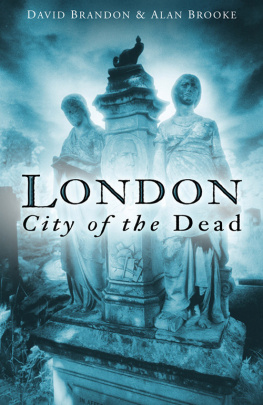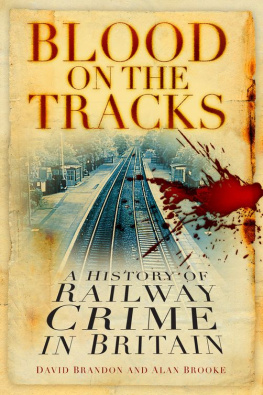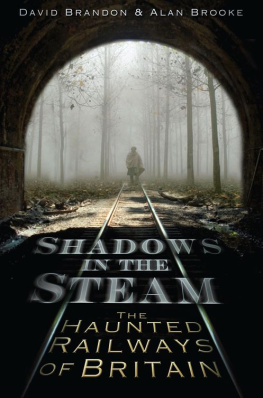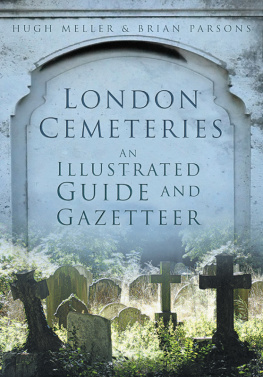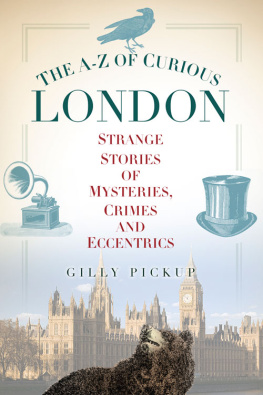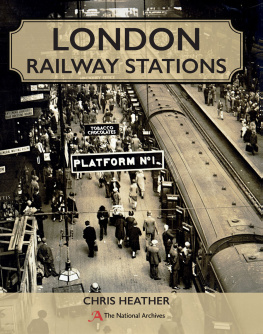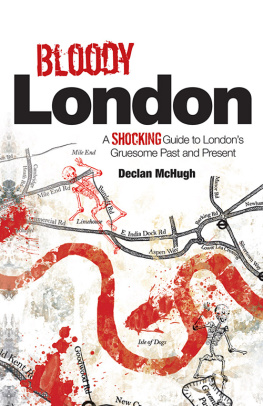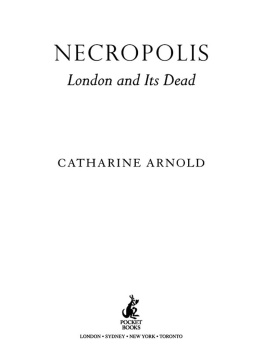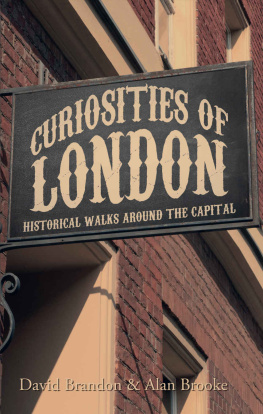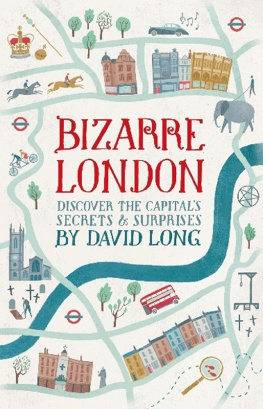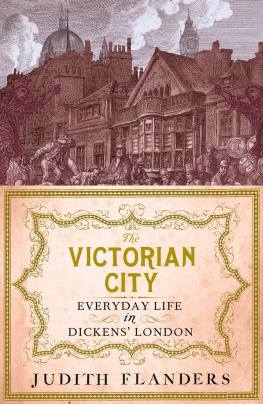L ONDON
City of the Dead
L ONDON
City of the Dead
DAVID BRANDON & ALAN BROOKE
Cover image courtesy of Simon Marsden
First published 2008
The History Press
The Mill, Brimscombe Port
Stroud, Gloucestershire, GL 5 2 QG
www.thehistorypress.co.uk
This ebook edition first published in 2013
All rights reserved
David Brandon & Alan Brooke, 2008, 2013
The right of David Brandon & Alan Brooke to be identified as the Author of this work has been asserted in accordance with the Copyrights, Designs and Patents Act 1988.
This ebook is copyright material and must not be copied, reproduced, transferred, distributed, leased, licensed or publicly performed or used in any way except as specifically permitted in writing by the publishers, as allowed under the terms and conditions under which it was purchased or as strictly permitted by applicable copyright law. Any unauthorised distribution or use of this text may be a direct infringement of the authors and publishers rights, and those responsible may be liable in law accordingly.
EPUB ISBN 978 0 7524 9617 7
Original typesetting by The History Press
Contents
Introduction
London has always been lethal. Death anticipated or brutally sudden has plucked the old, the young, the vulnerable, the innocent, the villainous, the foolhardy, the brave and the timorous from those around them and has done so with a callous and insouciant lack of discrimination.
Through much of the period under review, mortality in London was markedly higher than in any other part of the country. London could be a dangerous place. Life was short and early death was common. Death was a part of life and Londoners found ways of coping with its pervasive presence just as they managed to handle the other demanding challenges that came their way.
Has any city had more written about it than London? It seems that all the obvious and also every arcane or obscure aspect of its past have received the attention of writers over the centuries. Many of them have clearly been imbued with an absolute, uncritical love and awe of London. Others have been captivated, even spellbound, by the lure of the metropolis, but this attraction has sometimes been a mixed one, laced with concerns about Londons sheer enormity and the bewilderingly complex nature of its past. How can it be possible to comprehend even a small percentage of this? Yet others have found London at one and the same time fascinating and repulsive. For them it is like a great maelstrom: turbulent, confusing, threatening and on occasion destructive yet for all that, it is a constant source of attraction and excitement worthy of research and recording.
Because death has been such a feature of Londons past, it has inevitably been written about extensively and from a wide variety of approaches and angles. Books and articles galore have dealt with the effect of major epidemic diseases; with Londons murders and accidental deaths; its calamities and disasters; its judicial executions; the demise of particular Londoners, especially where these deaths have been unusual; with the development of measures to tackle avoidable death; with its statues and memorials; its rituals of commemoration; its places of interment, its cemeteries and ghosts; the evolution of mourning, death and burial practices; perceptions of the afterlife and controversies concerning death.
Why, then, another book dealing with death in London? This book is intended to be an informed, informative and hopefully entertaining general introduction to the subject of death in London. It is aimed at the general reader of history. It does not pretend to be all-inclusive; more specialised and detailed works on the subject are referred to in the bibliography and we have drawn on them extensively. The issue of death throws a fascinating light on so many aspects of the human condition and the development of culture and society. This books main thrust is to consider the everydayness of death in the life of Londons citizens and how that has been reflected in the culture they have created. It is this approach that the authors believe offers something that has not been specifically done before. The books time frame runs from the medieval period to the end of the First World War.
1
A Good Send-Off
Funerals, Feasts and Fashions
The pressing need to find more places to bury the dead in London became increasingly apparent as the population expanded from the sixteenth century. At the beginning of the century the population of London was approximately 70,000 with the majority living in the City, although there were significant numbers in Westminster and Southwark. By the late seventeenth century, this trend was reversed with about three-quarters of the population living outside the City. Between the sixteenth and the eighteenth centuries, London witnessed a significant transformation: it changed from being a compact settlement to a sprawling metropolis. Fields and meadows, waste and woodland, particularly to the west of the City, were consumed by this urban expansion. As London grew, it experienced rising rates of mortality and these prompted differing responses to the problem of how they should be tackled. The administrative means and the necessary scientific knowledge to do so effectively did not exist at this time.
Although there was a continuity of some pre-sixteenth-century rituals in relation to death, there were also changes which, by the mid-nineteenth century, amounted to the emergence of a mourning industry. The Victorian period became associated with a highly visible culture of mourning although much of the groundwork for this had begun in the eighteenth century. The proliferation of popular publications such as newspapers, magazines and books of etiquette, provided an outlet as well as an influence for the growing industry of death. Commercialisation, of which advertising was an important part, allowed the purveyors of mourning undertakers, businessmen, retailers, manufacturers of coffins and coffin furniture to promote their goods and services.
Medieval burials generally followed a standard Christian procedure but would vary according to social rank. Burials in this period included interment without a shroud; with a shroud (which was more common); in a shallow grave, wooden coffin, lead-lined coffin or stone sarcophagus; mausoleum burials; laying in an eastwest alignment and embalming. For the majority however the standard practice was burial in a shroud without a coffin. The distinction between a good death (a natural death, one which had been prepared for) as opposed to a bad death (unnatural such as suicide, accident or murder), was of absolute importance. Hence, the expectation was that one should be ready for death and be able to fulfil all the appropriate religious rituals and practices.
The deathbed epitomised a good death. As death became imminent, doors and windows would be opened in order that the soul could be released. A priest would usually arrive to administer the last rites and the dying person would be asked to declare his or her faith and to make confession. Having been absolved, anointed and commended in prayer, and once death had taken place, the body was washed, the eyelids closed (as this is the first part of the body where rigor mortis sets in), orifices plugged, body straightened then wound in a clean linen cloth or garment. In the period between death and burial, the body would be watched over, a ritual that dates back to at least the fourteenth century. Elements of this practice the wake and the viewing of the body have continued down to the present. After Mass the body was taken to the grave and sanctified by a priest. Family and friends would normally accompany the funeral procession bearing candles or torches. Those who were wealthy or held a prominent position were generally interred inside the church with a memorial. Most people would be buried outside the church in the graveyard or a burial site and could expect little more than a shallow mound marked with a wooden cross. In times of mass death such as during plague epidemics, disposal became more urgent and corpses were buried in large pits such as the Black Death cemetery in East Smithfield.

